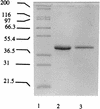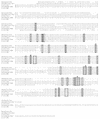Characterization of native and recombinant forms of an unusual cobalt-dependent proline dipeptidase (prolidase) from the hyperthermophilic archaeon Pyrococcus furiosus
- PMID: 9733678
- PMCID: PMC107500
- DOI: 10.1128/JB.180.18.4781-4789.1998
Characterization of native and recombinant forms of an unusual cobalt-dependent proline dipeptidase (prolidase) from the hyperthermophilic archaeon Pyrococcus furiosus
Abstract
Proline dipeptidase (prolidase) was purified from cell extracts of the proteolytic, hyperthermophilic archaeon Pyrococcus furiosus by multistep chromatography. The enzyme is a homodimer (39.4 kDa per subunit) and as purified contains one cobalt atom per subunit. Its catalytic activity also required the addition of Co2+ ions (Kd, 0.24 mM), indicating that the enzyme has a second metal ion binding site. Co2+ could be replaced by Mn2+ (resulting in a 25% decrease in activity) but not by Mg2+, Ca2+, Fe2+, Zn2+, Cu2+, or Ni2+. The prolidase exhibited a narrow substrate specificity and hydrolyzed only dipeptides with proline at the C terminus and a nonpolar amino acid (Met, Leu, Val, Phe, or Ala) at the N terminus. Optimal prolidase activity with Met-Pro as the substrate occurred at a pH of 7.0 and a temperature of 100 degrees C. The N-terminal amino acid sequence of the purified prolidase was used to identify in the P. furiosus genome database a putative prolidase-encoding gene with a product corresponding to 349 amino acids. This gene was expressed in Escherichia coli and the recombinant protein was purified. Its properties, including molecular mass, metal ion dependence, pH and temperature optima, substrate specificity, and thermostability, were indistinguishable from those of the native prolidase from P. furiosus. Furthermore, the Km values for the substrate Met-Pro were comparable for the native and recombinant forms, although the recombinant enzyme exhibited a twofold greater Vmax value than the native protein. The amino acid sequence of P. furiosus prolidase has significant similarity with those of prolidases from mesophilic organisms, but the enzyme differs from them in its substrate specificity, thermostability, metal dependency, and response to inhibitors. The P. furiosus enzyme appears to be the second Co-containing member (after methionine aminopeptidase) of the binuclear N-terminal exopeptidase family.
Figures





Similar articles
-
Characterization of a novel zinc-containing, lysine-specific aminopeptidase from the hyperthermophilic archaeon Pyrococcus furiosus.J Bacteriol. 2005 Mar;187(6):2077-83. doi: 10.1128/JB.187.6.2077-2083.2005. J Bacteriol. 2005. PMID: 15743956 Free PMC article.
-
Characterization of two proline dipeptidases (prolidases) from the hyperthermophilic archaeon Pyrococcus horikoshii.Appl Microbiol Biotechnol. 2010 Mar;86(1):177-88. doi: 10.1007/s00253-009-2235-x. Epub 2009 Sep 26. Appl Microbiol Biotechnol. 2010. PMID: 19784642
-
Characterization of an aminoacylase from the hyperthermophilic archaeon Pyrococcus furiosus.J Bacteriol. 2001 Jul;183(14):4259-68. doi: 10.1128/JB.183.14.4259-4268.2001. J Bacteriol. 2001. PMID: 11418567 Free PMC article.
-
Biotechnological applications of recombinant microbial prolidases.Adv Appl Microbiol. 2009;68:99-132. doi: 10.1016/S0065-2164(09)01203-9. Adv Appl Microbiol. 2009. PMID: 19426854 Review.
-
Targeting prolidase. A survey of the literature data to depict a structure-activity relationship frame and to address future studies for drug development.Bioorg Med Chem. 2024 Aug 1;110:117833. doi: 10.1016/j.bmc.2024.117833. Epub 2024 Jul 9. Bioorg Med Chem. 2024. PMID: 38996544 Review.
Cited by
-
Organophosphorus acid anhydrolase from Alteromonas macleodii: structural study and functional relationship to prolidases.Acta Crystallogr Sect F Struct Biol Cryst Commun. 2013 Apr 1;69(Pt 4):346-54. doi: 10.1107/S1744309113002674. Epub 2013 Mar 28. Acta Crystallogr Sect F Struct Biol Cryst Commun. 2013. PMID: 23545636 Free PMC article.
-
Properties and Applications of Extremozymes from Deep-Sea Extremophilic Microorganisms: A Mini Review.Mar Drugs. 2019 Nov 21;17(12):656. doi: 10.3390/md17120656. Mar Drugs. 2019. PMID: 31766541 Free PMC article. Review.
-
Crystal Structural and Functional Analysis of the Putative Dipeptidase from Pyrococcus horikoshii OT3.J Biophys. 2009;2009:434038. doi: 10.1155/2009/434038. Epub 2009 Jun 28. J Biophys. 2009. PMID: 20130794 Free PMC article.
-
A Systematic Analysis of the Structures of Heterologously Expressed Proteins and Those from Their Native Hosts in the RCSB PDB Archive.PLoS One. 2016 Aug 12;11(8):e0161254. doi: 10.1371/journal.pone.0161254. eCollection 2016. PLoS One. 2016. PMID: 27517583 Free PMC article.
-
Cloning, expression, and characterization of aminopeptidase P from the hyperthermophilic archaeon Thermococcus sp. strain NA1.Appl Environ Microbiol. 2006 Mar;72(3):1886-90. doi: 10.1128/AEM.72.3.1886-1890.2006. Appl Environ Microbiol. 2006. PMID: 16517635 Free PMC article.
References
-
- Adams M W W, editor. Enzymes and proteins from hyperthermophilic microorganisms. Adv Protein Chem. 1996;48:1–509. - PubMed
-
- Adams M W W, Kletzin A. Oxidoreductase-type enzymes and redox proteins involved in the fermentative metabolisms of hyperthermophilic archaea. Adv Protein Chem. 1996;48:101–180. - PubMed
-
- Andreotti G, Cubellis M V, Nitti G, Sannia G, Mai X, Adams M W W, Marino G. An extremely thermostable aromatic aminotransferase from the hyperthermophilic archaeon Pyrococcus furiosus. Biochim Biophys Acta. 1995;1247:90–96. - PubMed
Publication types
MeSH terms
Substances
Associated data
- Actions
LinkOut - more resources
Full Text Sources
Other Literature Sources
Molecular Biology Databases
Miscellaneous

